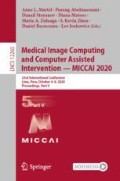Abstract
Survival prediction is a typical task in computer-aided diagnosis with many clinical applications. Existing approaches to survival prediction are mostly based on the classic Cox model, which mainly focus on learning a hazard or survival function rather than the survival time, largely limiting their practical uses. In this paper, we present a Censoring-Aware Deep Ordinal Regression (CDOR) to directly predict survival time from pathological images. Instead of relying on the Cox model, CDOR formulates survival prediction as an ordinal regression problem, and particularly introduces a censoring-aware loss function to train the deep network in the presence of censored data. Experiment results on publicly available dataset demonstrate that, the proposed CDOR can achieve significant higher accuracy in predicting survival time.
Access this chapter
Tax calculation will be finalised at checkout
Purchases are for personal use only
References
Chen, S., Zhang, C., Dong, M., Le, J., Rao, M.: Using ranking-CNN for age estimation. In: Proceedings of the IEEE Conference on Computer Vision and Pattern Recognition, pp. 5183–5192 (2017)
Cox, D.R.: Regression models and life-tables. J. Roy. Stat. Soc.: Ser. B (Methodol.) 34(2), 187–202 (1972)
Davidson-Pilon, C.: lifelines: survival analysis in Python. J. Open Source Softw. 4(40), 1317 (2019)
Harrell, F.E., Califf, R.M., Pryor, D.B., Lee, K.L., Rosati, R.A.: Evaluating the yield of medical tests. J. Am. Med. Assoc. 247(18), 2543–2546 (1982)
He, K., Zhang, X., Ren, S., Sun, J.: Deep residual learning for image recognition. In: Proceedings of the IEEE Conference on Computer Vision and Pattern Recognition, pp. 770–778 (2016)
Kingma, D.P., Ba, J.: Adam: a method for stochastic optimization. arXiv preprint arXiv:1412.6980 (2014)
Li, K., Xing, J., Su, C., Hu, W., Zhang, Y., Maybank, S.: Deep cost-sensitive and order-preserving feature learning for cross-population age estimation. In: Proceedings of the IEEE Conference on Computer Vision and Pattern Recognition, pp. 399–408 (2018)
Liu, J., et al.: An integrated TCGA pan-cancer clinical data resource to drive high-quality survival outcome analytics. Cell 173(2), 400–416 (2018)
Mobadersany, P., et al.: Predicting cancer outcomes from histology and genomics using convolutional networks. Proc. Nat. Acad. Sci. 115(13), E2970–E2979 (2018)
Niu, Z., Zhou, M., Wang, L., Gao, X., Hua, G.: Ordinal regression with multiple output CNN for age estimation. In: Proceedings of the IEEE Conference on Computer Vision and Pattern Recognition, pp. 4920–4928 (2016)
Reddy, C.K., Li, Y., Aggarwal, C.: A review of clinical prediction models. Healthc. Data Anal. 36, 343–378 (2015)
Schölkopf, B., Platt, J.C., Hoffman, T.: Ordinal regression by extended binary classification. In: Advances in Neural Information Processing Systems, pp. 865–872 (2007)
Steck, H., Krishnapuram, B., Dehing-Oberije, C., Lambin, P., Raykar, V.C.: On ranking in survival analysis: bounds on the concordance index. In: Advances in Neural Information Processing Systems, pp. 1209–1216 (2008)
Tang, B., Li, A., Li, B., Wang, M.: CapSurv: capsule network for survival analysis with whole slide pathological images. IEEE Access 7, 26022–26030 (2019)
Tang, Z., et al.: Pre-operative overall survival time prediction for glioblastoma patients using deep learning on both imaging phenotype and genotype. In: Shen, D., et al. (eds.) MICCAI 2019. LNCS, vol. 11764, pp. 415–422. Springer, Cham (2019). https://doi.org/10.1007/978-3-030-32239-7_46
Tang, Z., et al.: Deep learning of imaging phenotype and genotype for predicting overall survival time of glioblastoma patients. IEEE Trans. Med. Imaging 39, 2100–2109 (2020)
Yao, J., Zhu, X., Huang, J.: Deep multi-instance learning for survival prediction from whole slide images. In: Shen, D., et al. (eds.) MICCAI 2019. LNCS, vol. 11764, pp. 496–504. Springer, Cham (2019). https://doi.org/10.1007/978-3-030-32239-7_55
Zhu, X., Yao, J., Huang, J.: Deep convolutional neural network for survival analysis with pathological images. In: IEEE International Conference on Bioinformatics and Biomedicine, pp. 544–547 (2016)
Zhu, X., Yao, J., Zhu, F., Huang, J.: WSISA: making survival prediction from whole slide histopathological images. In: Proceedings of the IEEE Conference on Computer Vision and Pattern Recognition, pp. 7234–7242 (2017)
Acknowledgement
This work was supported by the National Natural Science Foundation of China under Grant 61703166 and Grant 61633010, the National Key Research and Development Program of China under Grant 2017YFB1002505, the Guangdong Natural Science Foundation under Grant 2014A030312005, the National Key Basic Research Program of China (973 Program) under Grant 2015CB351703, the Guangzhou Science and Technology Program under Grant 201904010299, and the Fundamental Research Funds for the Central Universities, SCUT, under Grant 2018MS72.
Author information
Authors and Affiliations
Corresponding author
Editor information
Editors and Affiliations
Rights and permissions
Copyright information
© 2020 Springer Nature Switzerland AG
About this paper
Cite this paper
Xiao, L. et al. (2020). Censoring-Aware Deep Ordinal Regression for Survival Prediction from Pathological Images. In: Martel, A.L., et al. Medical Image Computing and Computer Assisted Intervention – MICCAI 2020. MICCAI 2020. Lecture Notes in Computer Science(), vol 12265. Springer, Cham. https://doi.org/10.1007/978-3-030-59722-1_43
Download citation
DOI: https://doi.org/10.1007/978-3-030-59722-1_43
Published:
Publisher Name: Springer, Cham
Print ISBN: 978-3-030-59721-4
Online ISBN: 978-3-030-59722-1
eBook Packages: Computer ScienceComputer Science (R0)


